보름달이 떠도 페르세우스 유성우는 쏟아진다.
[해가 쨍쨍한 날은 비가 안오지만 달이 휘엉청 밝아도 유성비는 쏟아진다.]
BY: BOB KING AUGUST 11, 2022
https://skyandtelescope.org/astronomy-news/perseids-are-coming-full-moon-or-not/
Don’t use a full Moon pass to skip this year’s Perseid meteor shower. Right here, right now, we’re going to help you make the most of it.
보름달 때문에 올해 페르세우스 유성우 관찰을 미리 포기하지 마세요. [굳이 직역하자면 '올해의 페르세우스 유성우를 지나치려고 보름달 회수권(pass)을 쓰지 말라' 쯤 되겠다.] 지금 곧바로 유성우 관찰을 위한 도움을 모두 드리겠습니다.
[관측뿐만 아니라 유성우의 이해에 필요한 정보들도 제공 하겠다. 별보기는 그저 보는 행위와 함께 천문현상의 이해를 포함한다.]
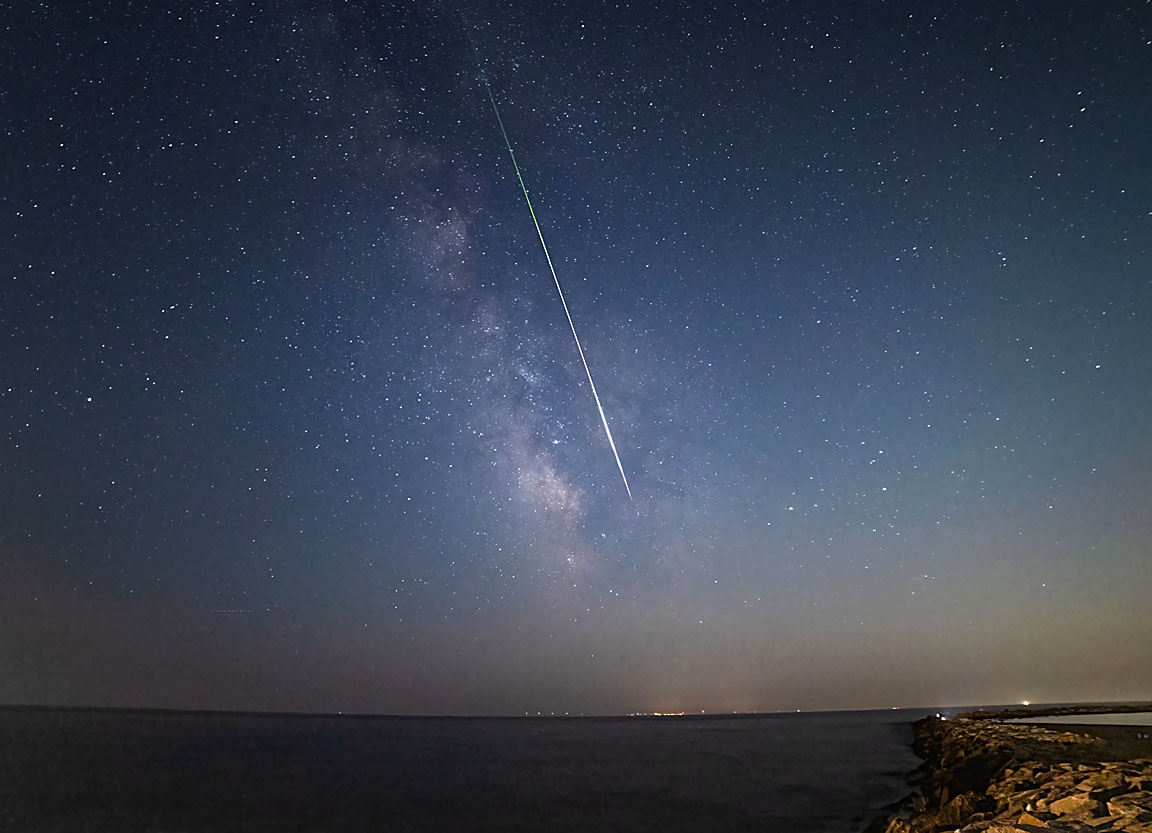 |
| A bright Perseid shoots down along the Milky Way over Narraganset Bay, Rhode Island, on August 13, 2021. "I set the camera up to take a 13-second exposure, one after another, at f/2.8, 3200 ISO for one hour," writes Peter Ryan. "I never actually saw that fireball that evening until I looked in my camera, and you can’t even imagine how amazed I was when I started flipping through all the photos . . . and then all of a sudden that big fireball . . . it was soooooo awesome." Peter Ryan |
Skywatchers are fond of alignments but not those where a bright Moon coincides with the peak of a major meteor shower. In this year's roll of the dice the annual Perseid maximum falls just a day after the full Sturgeon Moon.
별지기(skywatcher, 천체관측자는 물론 점성술사 들도 포함해서)들은 정렬(alignments, 천체들이 줄지어 서면 볼꺼리 뿐만 아니라 갖가지 썰들이 난무한다. 망원경 렌즈나 거울을 조정할때도 광축정렬이란 말을 씀)을 좋아하죠. 하지만 중요한 유성우의 극대기에 밝은 달이 함께하는 것까지 좋아하진 않습니다. 올해 연간 페르세우스 유성이 최대로 떨어지는 시기가 철갑상어 달(Sturgeon Moon)이 보름이 되는 다음날에 하필이면 맞아떨어 졌습니다(=roll of the dice).
[(미국에서)달을 수식하는 말이 꽤나 다양한데 대부분 고대로부터 북미원주민, 신대륙개척자들, 유럽의 농부들이나 주술사들의 달력에서 유래했다. 8월은 그레이트 호, 채프린 호수 등지에서 대 철갑상어 잡이 시기라 붙여 졌다고 한다. https://www.almanac.com/content/full-moon-august]
Despite the light bath, there's still hope for a good show for a couple of reasons. First, the shower is prolific — Perseids flash by at the rate of more than one a minute. Even if you reduce that by more than half due to moonlight, that's still around 25 per hour. Second, this famous annual shower is the undisputed king of fireballs, according to Bill Cooke at NASA's Meteoroid Environment Office. The American Meteor Society (AMS) defines a fireball as a meteor "generally brighter than magnitude -4" or the equal of Venus or brighter.
달빛(=the light bath)이 쏟아진다 손 치더라도 꽤 좋은 [유성우의]모습(good show)을 보게될 몇가지 이유가 있습니다. 먼저, 이번 유성우는 우량이 꽤 많을(prolific) 거라는 점이죠. 페르세우스 유성우[Perseids, -ids 는 유성우를 뜻하는 접미사] 일분에 하나꼴로 반짝일 것입니다. 달빛 때문에 절반박에 못본다 쳐도 시간당 25개의 유성우를 볼 수 있죠. 그다음으로 페르세우스 유성우는 연간 유성우중 가장 유명한데 미국 항공우주국의 유성 환경실의 빌 쿡씨에 따르면 올해는 전례없이 큰 화구(ball of fire, 또는 fireball 이라고도 함)를 보게 될 거라고 말했습니다. 미국 유성 협회(AMS)는 화구(fireball)를 "-4등성 보다 시각적으로 밝은 유성"이라고 정의 했는데 금성(Venus) 정도의 밝기 입니다.
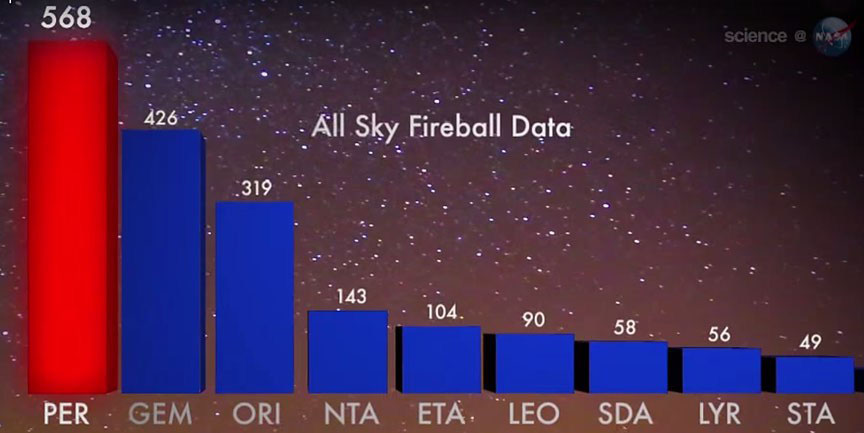 |
| The Perseids (PER) and Geminids (GEM) are tops when it comes to producing fireballs, giving observers hopes for a reasonably good show despite moonlight. NASA |
GREAT BALLS OF FIRE
거대 화구
Cooke and team monitored the shower between 2008 and 2013 and recorded 568 fireballs compared to the second-place Geminids with 426. The greater percentage may have to do with the considerable size of the Perseids' parent body, Comet 109P/Swift-Tuttle, which has a diameter of around 26 kilometers. Bigger comets like 109P release more material when baked by the Sun, resulting in a greater number of larger pieces. And larger meteoroids typically produce brighter flashes when they enter the atmosphere.
쿡과 동료들은 2008년부터 2013년까지 유성우를 관측해왔고 568개의 화구를 기록했는데 두번째로 많은 유성우는 쌍동이자리 유성우(Geminids)의 426개 였습니다. 페르세우스 유성우의 상당한 크기를 가진 대다수는 스위프트-터틀 혜성(Comet 109P/Swift-Tuttle)의 몸에서 떨어져 나온 겁니다. 이 혜성의 둘레는 26킬로미터에 달했습니다. 109P (혜성에 일련번호를 메김, 스위프트-터틀은 혜성 발견자 이름)혜성처럼 거대 혜성은 태양에 달궈지면서 많은 부스러기(=material)들을 남기는데 그 조각들의 크기가 꾀 크죠. 큰 조각 유성이 대기권에 떨어지면 더 밝은 섬광을 냅니다.
"The average peak magnitude for a Perseid observed by our cameras is –2.7; for the Geminids, it is –2,"explains Bill Cooke. "So on average, Geminid fireballs are about a magnitude fainter than those in the Perseids." Most Perseids are the size of sand grains with a few "chocolate chips" thrown in for good measure. In a 2004 paper that appeared in the Monthly Notices of the Royal Astronomical Society, a team of Canadian astronomers estimated that it only takes a comet shard about 30 mm (1.2 inches) across to create a –6 magnitude fireball.
"우리의 카메라에 잡힌 페르세우스 유성들의 평균 최고 밝기는 -2.7등급 이었는데 쌍동이 유성우의 경우 2등급 밝기 입니다. 평균적으로 쌍동이 유성우의 밝기는 페르세우스 유성우보다 한등급 아래죠." 페르세우스 유성의 크기는 대부분 모래알 크기인데 그중 '초코릿 조각' 만한게 섞여 있는 겁니다. 2004년에 왕립 천문학회 월간 회보에 실린 캐나다 연구자들의 논문에 따르면 혜성에서 떨어진 직경 약 30밀리미터 크기 조각은 -6등급의 화구를 보여줬을 것이라고 합니다.
Comet 109P/Swift-Tuttle makes a pass through the Sun's hot kitchen every 133 years. Each time, it loses a fraction of its mass as dust and rocks that fans out into a broad stream of debris. Earth makes contact with the stream's fringes in mid-July and doesn't exit until the end of August. In fact, during the recent Southern Delta Aquariid shower, which peaked on July 30th, I counted more Perseids (five) than Delta Aquariids (three) in an hour, proving that Earth was already knee-deep in the flow nearly two weeks before maximum.
스위프트-터틀 혜성은 133년의 주기로 태양의 뜨거운 부엌을 지납니다. 그때마다 자기 질량중 상당량의 잃게 되는데 먼지와 돌조각들로 기다란 찌꺼기의 띠를 펼쳐 놓고 가죠. 지구가 7월 중순부터 혜성찌꺼기의 강가(stream's fringe)에 도달 했다가(=make contact) 8월 말에 까지는 다 건너지 못합니다. 실제로 최근 7월 30일에 있었던 남 삼각물병 유성우의 최대 였을 때도 페르세우스 유성은 시간당 5개로 삼각 물병의 3개 보다도 많이 헤아릴 수 있었습니다. 이는 최대기의 2주전에 이미 지구는 강 수위가 무릅까지 차오른 지점에 왔다는 뜻입니다.
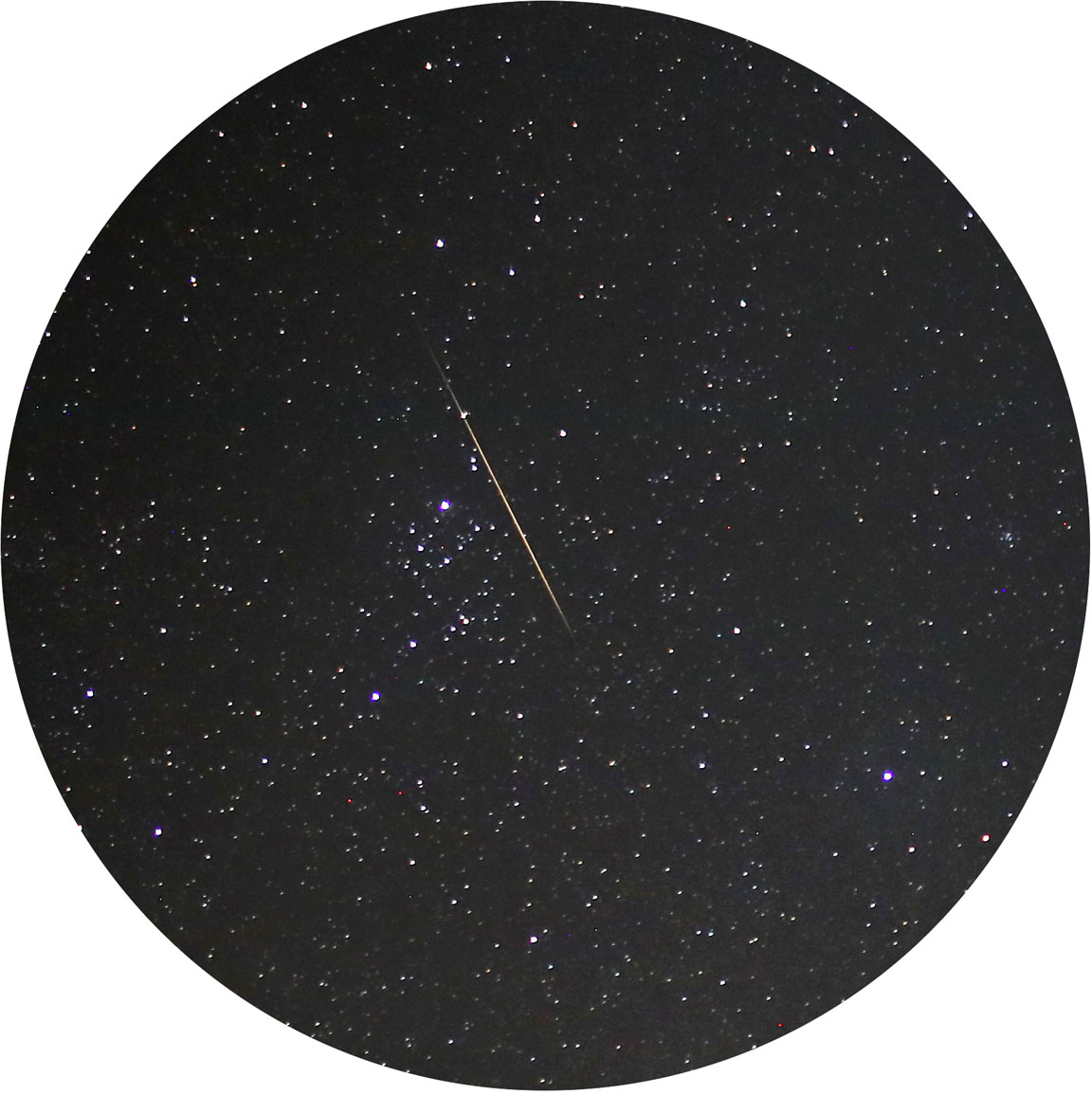 |
| An early Perseid zips past the star Mirfak (Alpha Persei) before dawn on July 30, 2022. Bob King |
VIEWING OPPORTUNITIES
관측 적기
The real action happens when we speed through the stream's core which occurs on August 13th around 1:00 UT (August 12th, 9 p.m. EDT). For North American observers that puts the peak of the shower on Friday night August 12–13. If the weather forecast looks grim, the previous evening (August 11–12) should be nearly as good. Alternatively, you can avoid moonlight altogether for one precious hour on Wednesday morning August 10th beginning around moonset at 3:30 a.m. local time until the first blush of dawn.
우리 지구가 혜성 찌꺼기 강의 중심을 달릴 때 큰일이 벌어지는데 8월 13일경 01시 UT(국제표준시, 우리나라 시각으로 12일 오후 4시)경 입니다. 북미 관측자들에겐 최대 쏟아지는 시각이 12일과 13일 금요일 밤 이 될겁니다. 일기가 우중충(grim) 하면 그 전날 저녁도 꽤 괜찮을(nearby as good) 겁니다, 아니면 달빛을 피해보고자 하면 8월 10일 해뜨기 한시간 전부터 푸르스름한 새벽도 괜찮은데 달이 3시30분에 지니까요.
That brief window of darkness will also be an ideal time for meteor photography. I like shooting 30-second exposures wide open at f/2.8 with a wide-angle lens (16- to 20-mm) at ISO 1600 or 2500. With the full Moon out, photos are still possible, but you'll need to reduce exposure time and lower your ISO, necessarily capturing fewer "shooting stars."
그 짧은 어둠의 시간대[달이지고 동트기 직전까지 한시간 가량]는 유성사진 찍기에도 좋습니다. 광각렌즈(16~20미리)의 조리개를 f2.8로 개방하고 약 30초 노출을 줍니다. ISO 1600에서 2500정도를 사용하죠. 보름달이 있어도 사진을 못찍진 않겠지만 노출을 줄이고 필름 감도를 낮춰야 합니다. 당연히 '별똥별' 숫자는 적을 겁니다.
PERSEID STREAMING SERVICE
페르세우스 유성 띠
It's tempting to visualize the comet's debris trail as a Saharan sand storm. But the 2004 paper cites an earlier study that determined that there are just 90 ± 16 meteoroids per 1 billion cubic kilometers of space capable of producing meteors brighter than magnitude 6.5. For reference it takes our planet about 15 minutes to sweep across a volume of that size.
사하라 사막의 모래폭풍 처럼 혜성의 잔해물을 시각화 하려는 노력이 있습니다. 하지만 이전의 연구를 참조한 2004년의 논문을 인용하면 10억 평방 키로미터의 공간에 6.5등급이상의 밫을 낼 잔해의 갯수는 고적 90개 남짖이라고 합니다. 이는 우리 지구가 약 15분간 쓸고 지나갈 공간의 크기에 해당하죠.
[혜성의 찌꺼기 띠의 멋진 모습을 보고 싶다면 https://www.meteorshowers.org/ 를 방문해 보시라.]
The combined motion of the Perseid stream and Earth's orbital hurry keep the meager supply of visible meteoroids coming and help us to form a mental image of the space we must cover to see even a single Perseid, let alone 20 or 30. Play with the interactive visualization of the shower (above, by Peter Jenniskens and Ian Webster) to get a real, 3D-feel for the event we're about to witness.
The emissaries of Swift-Tuttle may only be as big as sand grains or at best one of those shredded wheat pillows, but they're traveling at more than 200,000 kilometers per hour when they encounter Earth's atmosphere.
스위프트-터틀의 특사들(emissaries, [혜성에서 떨어져 나와 지구를 방문하는 조각들])은 고작 모래알 만하거나 커봐야 곡식 알갱이 만 하지만 시속 20만 키로미터의 속도로 지구의 대기권을 뚫는다.
RAMMING HOME THE POINT
Ram pressure — the rapid compression of air in front of the speeding particle —quickly heats it to more than 1650°C (3000° F), much like the heat shield of a spacecraft reentering the atmosphere. That's hot enough to ablate the incoming meteoroid, ionizing its atoms as well as the air molecules along its path. This creates a dense, glowing channel of plasma many times the size of the original particle. In a word — a meteor. I find it nothing short of astonishing to witness the transformation of an insignificant crumb into a blaze of light that makes you want to raise a fist and shout "YES!"
빠르게 돌진하는(speeding) 알갱이가 전면으로 받는 마찰압력(ram; 숫양, 격돌하다)은 급격하게 가열되는데 섭씨 1650도까지 올라갑니다. 지구로 재진입 하는 우주왕복선의 열차폐체가 받는 온도와 같습니다. 떨어지는 알갱이(meteoroid: 유성체)를 분해해서(ablate) 경로중에 놓인 공기분자와 함께 원자를 이온화 시킨다. 결국 원래크기보다 훨씬 큰 플라즈마의 밀집되고 빛나는 띠(channel of plasma)를 만들어낸다. 이것이 바로 유성 입니다. 작은 부스러기(insignificant crumb)가 불줄기(blaze of light)로 변하여 눈군가 손가락을 들고 "저기다!"라며 소리를 지르게 만드는 놀람의 짧은 순간일 뿐입니다.
[떨어지는 유성에 물리-화학적으로 엄청난 일이 벌어지지만 탄성을 지르게 하며 순간에 끝난다.]
You can begin watching for Perseids as early as 9:30–10 p.m. local time, when the radiant has barely risen in the northeastern sky. That's the ideal time to spot meteors arriving nearly tangent to the upper atmosphere called earthgrazers. Skittering through the thin air like stones skipping on water, they travel long distances across the sky and sometimes glow for many seconds. The radiant itself is just an optical illusion, a vanishing point like parallel railroad tracks or crepuscular rays that appear to converge in the distance. Like those tracks and rays, Perseids enter on separate parallel paths as Earth lunges into Swift-Tuttle's detritus.
페르세우스 유성은 밤 9시반에서 10시 사이에 북서쪽 하늘에서 서서히 떨어지기 시작합니다. 유성을 포착(spotting)하기 가장 좋은 시간은 유성이 대기층의 접선 방향으로 스쳤다가 다시 튕겨나가는 어스-그레이저(earth-grazer)가 다가올 때 입니다[이때 유성의 빛이 하늘을 길게 가로 지른다.] 마치 물수제비(skittering on water)처럼 하늘을 길게 스치는데(skitter) 때로는 수초간 지속되기도 합니다. 확산하여 떨어지는 모습(the radiants)은 그저 황홀 합니다. 평행하게 이어졌다 사라지는 철길 같기도 하고 저 먼곳에 이어진 어슴프레한(crepuscular) 빛줄기 같기도 합니다. 지구가 스위프트-터틀 혜성이 남긴 파편(detritus)들 속으로 돌진(lunge)할 때 페르세우스 유성은 철길이나 빛줄기 같은 평행한 흔적을 남깁니다(=enter on: 뛰어들다).
CITIZEN SCIENCE
The higher the radiant climbs the more meteors you'll see, with the best hours from about 2–4:30 a.m. No matter the hour, invite a friend or family members and set up somewhere with a wide-open view of the sky. Sit halfway up in a reclining chair for the best view. Perseids will appear anywhere in the sky, but given torrential moonlight, your best bet is to face north with the Moon at your back and the radiant off to your right. Perseids are distinguished from random or sporadic meteors because they point back to the radiant in Perseus.
If you'd like to record your meteor observations for personal use, download this blank form from the AMS. You can also contribute that data to the International Meteor Organization (IMO), which partners with the AMS, by first registering on the IMO website (it's free). Each meteor you see provides a nugget of useful scientific data to improve our understanding of the year's most popular shower.
If you're utterly clouded out or otherwise unable to see the shower in person, astronomer Gianluca Masi will live stream the Perseids on August 10th starting at 01:00 UT (9 p.m. EDT, August 9th) on his Virtual Telescope site. Also, the Spanish language Sky-live.tv will broadcast the Perseids live from the island of Madeira and an observatory in the Canary Islands on August 13th starting at 01:00 UT (9 p.m. EDT, August 12th).
I share your hope for clear skies — enjoy the show!
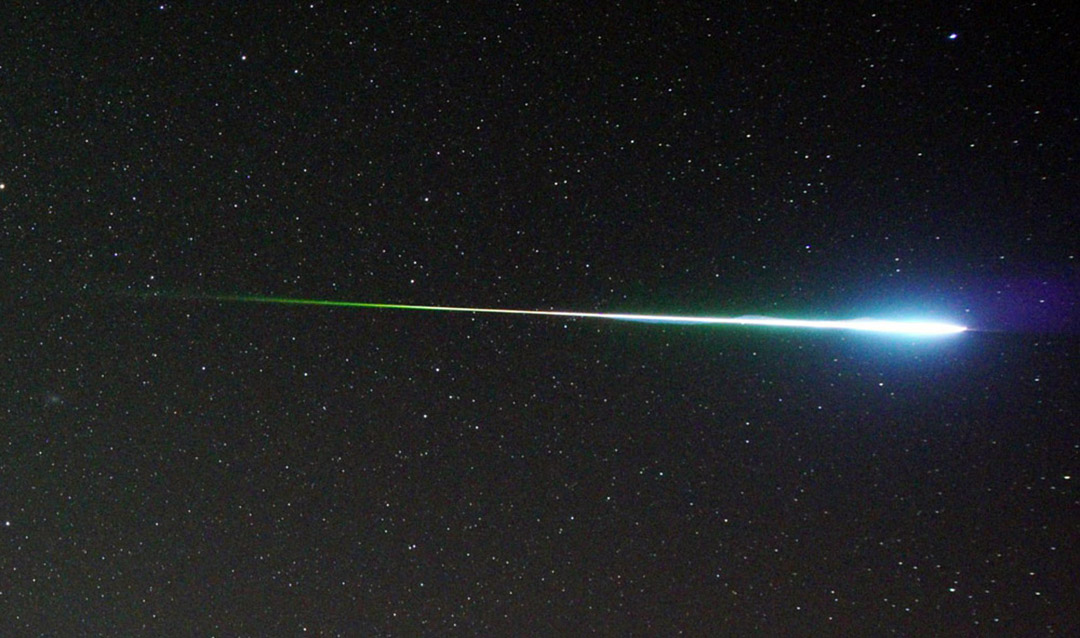
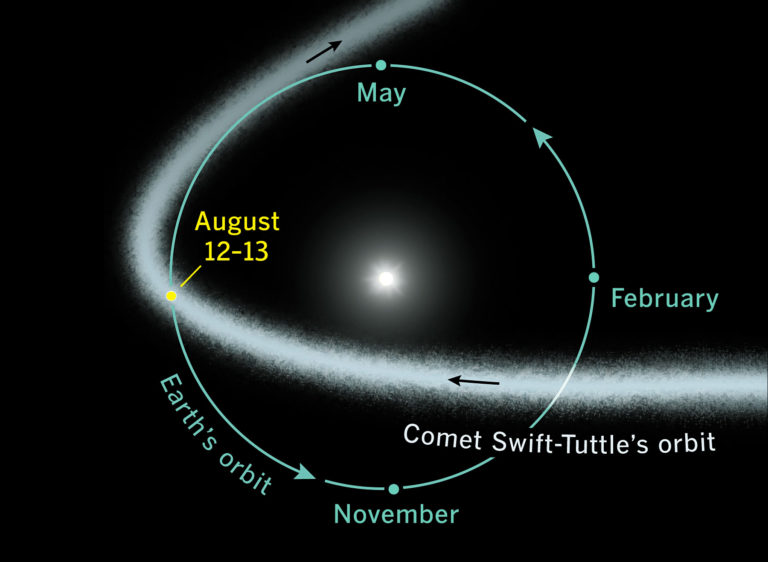
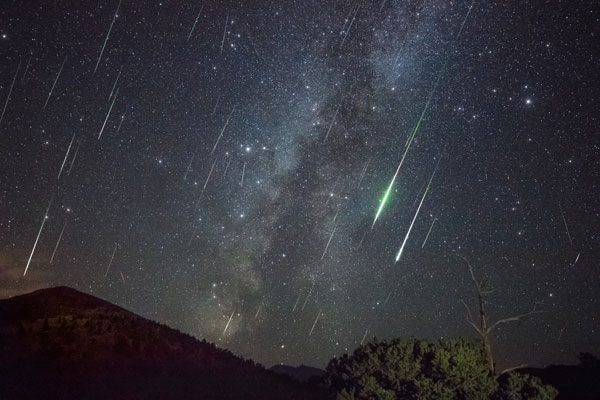
댓글 없음:
댓글 쓰기